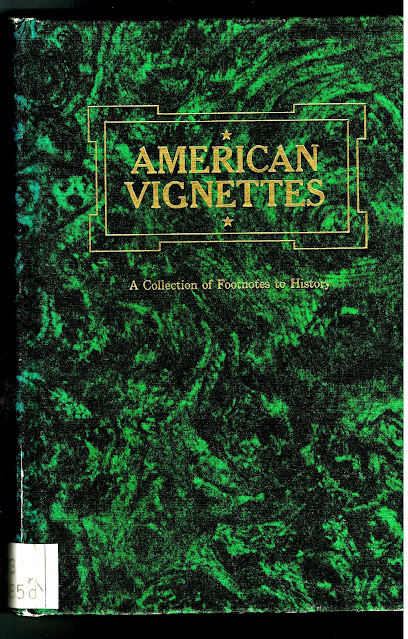Last week I started a new series of blog posts about stuff I bring home from our local public library. Today, the second post in the series.
I came across this smallish volume in a used bookstore somewhere, in the days when I would set a budget for myself. I did it fcor the same reasons that some people visiting Las Vegas will bring only the money they are willing to lose. I remember thumbing through the pages of American Vignettes and finding myself drawn in, but I'd already spent the twenty bucks or whatever my amount was, so I left the book behind. And then regretted it for years. Recently I did a little internet research and realized that the item now sold for more than I wanted to pay. But our statewide library system had it listed and my local library ordered it for me.
The author, the late John I. White, was less famous for American Vignettes than he was for either history-based magazine articles or for his work on old-time radio. He also wrote a book, published by the Univerity of Illinois Press, about cowboy songs. His bio for Git Along Little Dogies says in part; "A former singing cowboy himself, John I. White spent decades compiling information on cowboy and western songs and the artists, songwriters, and others attached to them... From "Whoopee Ti Yi Yo" to "Ten Thousand Cattle Straying," Git Along, Little Dogies ventures from cow camps to saloons to big-city radio studios as it lassos a vivid piece of American music history."
Speaking of "Whoopee Ti Yi Yo," I found a YouTub video which contains John White singing the song, with impressive yips.
John White sang on the old-time radio version of "Death Valley Days" and this was the reason his brief obituary appeared in the Los Angeles Times. "John I. White found fame as the Lonesome Cowboy on the radio drama Death Valley Days in the 1920s and 1930s. He later became a businessman and magazine writer."
Some sheet music ffom White's radio heyday. .
So White wrote (or compiled) American Vignettes in his senior years, and then some time after 1976, it sat around on a used bookstore shelf till I encountered it. The compelling illustrations originally helped draw me into American Vignettes, so some years later, when I picked up the library copy, I saw that the illustrator's name was Jerry Allison. A quite internet search brought up THIS BIO on a blog called The Shattered Lens. The blog revealed the fgact that Allison did a lot of cover art for noir-ish paperbacks of the 1950s. Many of them were considerably more lurid than this one.
Speaking of Esso / Exxon, there's a connection between American Vignettes' tillustrator, Jerry Allison, and the book's publisher, TravelVision.

TravelVision published American Vignettes within a line of items given out to members of the Exxon Travel Club.
If you always wanted to be part of the Exxon Travel Club, you can go onto online auction sites and bit on "mid-century" swag to be left around your house casually to impress visitors.
By the bye, I discovered this week that he Travel Vision / Exxon people put out a companion volume to American Vignettes. It's called American Journeys and the cover has the same marbelized swirly pattern but it's reddish or orange-ish. I'll know which color for sure when I pick up the library copy, which I just reserved. And while I was at the library site, I also asked to get a copy of White's singing-cowboy book Git Along Little Dogies. Perhaps one or both with make it into this blog series..













No comments:
Post a Comment